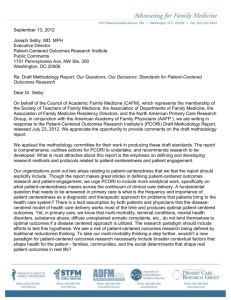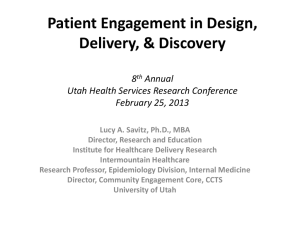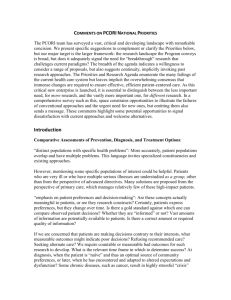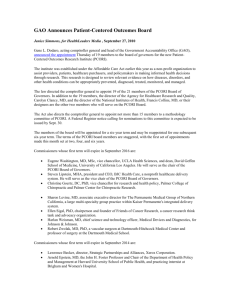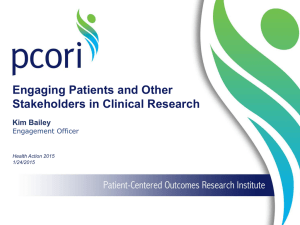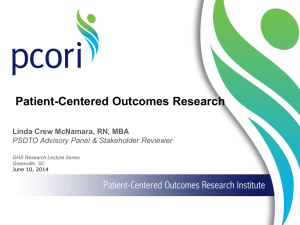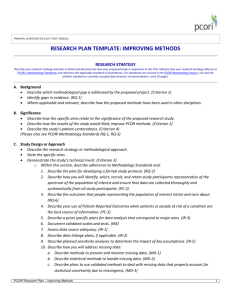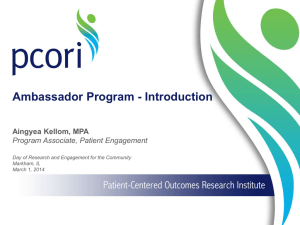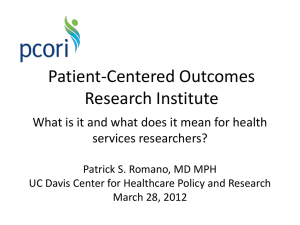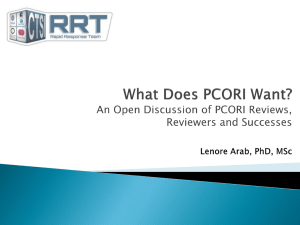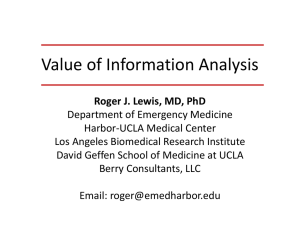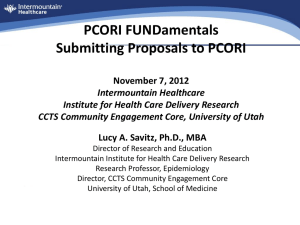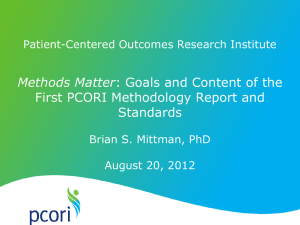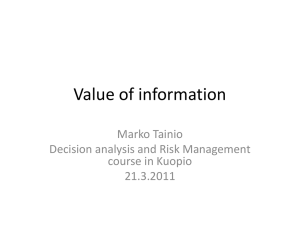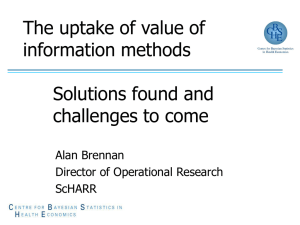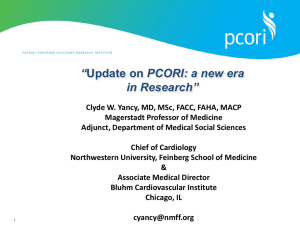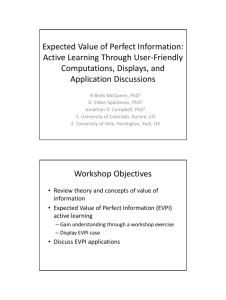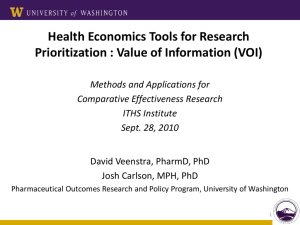slides - C-MORE
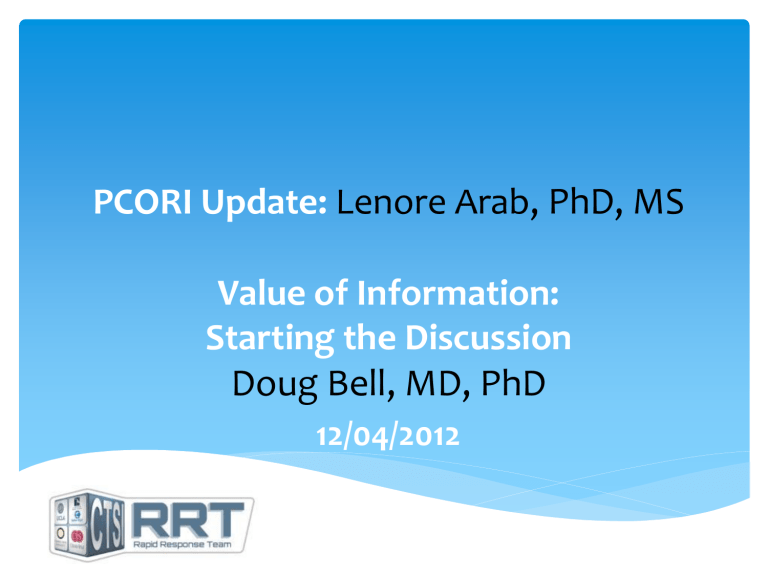
PCORI Update: Lenore Arab
, PhD, MS
Value of Information:
Starting the Discussion
Doug Bell, MD, PhD
12/04/2012
The Rapid Response Team:
Who We Are
Director, Dr. Lenore Arab
Project Coordinator, Robin Faria
Study Coordinator, Erica Sasman
Outline
PCORI Evolving Structure
PCORI Status of Current Applications
Currently Open RFAs: January & February 2013 LoIs
Future PCORI Disease Priority Areas
Value of Information Analyses- why you should care, and what it might entail
PCORI Organization: Divisions
Status of Current Proposals
PCORI Funding Opportunity 5:
Inaugural Cycle
Topic
Improving Methods for Conducting Patient-Centered
Outcomes Research
Due Dates
LOI (required): 1/15/2013; 6/15/2013; 10/15/2013
Application: 3/13/2013; 8/15/2013; 12/17/2013
Funding
$250,000 direct per year for three years (shorter duration encouraged)
Improving Methods for Conducting
Patient-Centered Outcomes Research I
Specific Questions of Interest
1.
Development of methods for patient centeredness
2.
Research in methods to conduct systematic reviews of patientcentered comparative effectiveness research.
3.
Development of methods for generating, selecting, and prioritizing topics for research and for including patients and stakeholders in the peer‐review process.
4.
Development and refinement of general analytic methods.
5.
Development and refinement of design‐specific analytic methods.
Improving Methods for Conducting
Patient-Centered Outcomes Research II
Specific Questions of Interest, Continued
6. Research that determines the validity and efficiency of data sources commonly used in PCOR.
7. Research related to Patient-Centered Outcomes (PCOs) and
Patient-Reported Outcomes (PROs).
8. Research in methods to enhance the reproducibility, transparency, and replication of PCOR research.
9.
Research that evaluates and compares strategies for training researchers, patients, and other stakeholders in the methods of patient‐centered outcomes research.
PCORI Funding Opportunity,
Cycle III – 3
rd
Opportunity
Topics
Assessment of Prevention, Diagnosis, and Treatment
Options
Improving Healthcare Systems
Communication and Dissemination Research
Addressing Disparities
Due Dates
LOI (required): 2/15/2013
Application: 4/15/2013
Funding
$500,000 direct cost per year for xx years?
PCORI Interest Survey
Purpose of Survey: to actively engage faculty interested in PCORI research and find ways to further help the research community in areas of interest
Incentive: two winners per week for $50 gift card
Preliminary Results on Week 1 of Survey:
34 respondents
First winners to be announced Thursday
Cycle II and Cycle III Interest:
Yes
No
Undecided
Total
3
17
13
33
Assessment of
Prevention
Communication &
Dissemination
0
3
3
1
2
3
Improving
Healthcare
Systems
2
3
5
Addressing
Disparities
1
6
7
Accelerating
Patient-
Centered
Outcomes
1
5
6
PCORI Staff Choice of Disease Priority Areas
Value of Information: Starting the
Discussion
Douglas Bell, MD, PhD
Input Variables and Values for
Treatment A and B
Parameter
Cure rate
Life expectancy if cured
Life expectancy if treatment fails
Costs of managing treatment failure
Overall complication rate
Mortality rate after complication
Cost of complication
Costs associated with fatal complication
Treatment A
(95% CI)
94%
(86.0 to 98.6%)
20 years
Treatment B
(95% CI)
90%
(83.5 to 95.0%)
5 years
20%
(10.0 to 27.5%)
$50,000
10%
(8.2 to 12.0%)
5%
(2.1 to 10.0%)
$10,000
$50,000
Expected Values of Outcomes of
Interest Given Treatment A or B
Outcome
Mean life expectancy
Mean costs
Mortality from complications of treatment
Treatment A Treatment B
18.72 years 18.40 years
$10,940
2.0%
$10,725
0.5%
1
Outcomes from 10 Simulations of Treatment A and B Assuming a WTP Threshold of $750
Simulation
Number
Net Benefits
Treatment A
Net Benefits
Treatment B
Maximum
Net Benefits
Preferred
Strategy
Opportunity
Cost
$4,180 $4,306 $4,306 B $0
4
5
2
3
6
7
8
9
10
Expected value
(mean of simulations 1-10)
$2,273
$7,095
$3,186
$3,504
$5,698
$4,762
$3,960
$5,071
$1,904
$4,163
$2,415
$4,507
$4,017
$3,433
$6,740
$3,718
$1,919
$5,964
$5,123
$4,214
$2,415
$7,095
$4,017
$3,504
$6,740
$4,762
$3,960
$5,964
$5,123
$4,789
B
A
A
B
B
B
A
B
A
$0
$2,588
$0
$72
$0
$1,044
$2,041
$0
$0
$575
Value of Information
An approach to research prioritization which uses Bayesian methods to estimate the potential benefits of gathering further information (through more research) before making a decision
(Meyers, et al., 2012)
A tool of the decision sciences, estimates the potential economic losses associated [with] choosing suboptimal policies when that decision is made with uncertain information (Rhein, 2012)
A decision analytic technique that explicitly evaluates the benefit of collecting additional information to reduce or eliminate uncertainty. (Yokota and Thompson, 2004)
General Challenges to the Use of
VOI for Research
Prioritization
Resources needed to develop appropriate models
Personnel
Time
Computing Resources
Scope of VOI
Prioritizing across disease areas
Prioritizing within a condition
Prioritizing specific comparative effectiveness research
Stakeholder Engagement
Lack of familiarity with the methodology
Timing of VOI
Resources Needed to Conduct
VOI
Personnel
Time
Computing Resources
“minimal modeling appears to be most useful when an intervention affects quality of life alone” 3
Expected Value of Perfect
Information (EVPI)
Difference between the expected value given perfect information and the value given current information
i.e. the upper bound of the opportunity cost of making a wrong decision; any effort to improve the quality of available data that costs less than the EVPI is worth pursuing
Calculating EVPI
EVPI is calculated as the expected value of a decision made with perfect information minus the expected value of a decision made with the existing information:
EVPI = E
max j
NB(j,
) max j
E
NB(j,
)
Using EVPI for Research
Prioritization
Go/no go measurement to determine if additional research is appropriate
Comparison for cost effectiveness of research across different interventions
Expected Value of Partial Perfect
Information (EVPPI)
The value of being able to know the outcome of another related uncertainty instead of the original value itself before making a decision. It is quantified as the highest price the decision-maker is willing to pay for being able to know the uncertainty before making a decision. Note that it is essentially the value of perfect information on the second variable.
Using VOI by Research Sponsor, such as PCORI
Perform VOI prior to solicitation for research proposals and only request areas identified as having acceptable EVPI/EVPPI
Perform VOI after initial review of proposals as part of funding decisions with higher EVPI/EVPPI receiving higher priority for funding
Research sponsor could encourage or require investigators to include VOI analysis as part of rationale for proposals
Treatment Decision Tree
Common uses of VOI
Justify additional research in advance of adapting specific interventions
Identifying which areas contribute the most to uncertainty
References
Patient-Centered Outcomes Research Institute Board of Governors Meeting, www.pcori.org
, 2012.
Minimal Modeling Approaches to Value of Information Analysis for Health
Research, Metlzer, et al. www.ahrq.gov
, 2011.
Systematizing the Use of Value of Information Analysis in Prioritizing Systematic
Reviews. Hoomans, et al. www.ahrq.gov
, 2012.
Value of Information and Research Prioritization. Rein. NORC at the U of Chicago,
2012.
Value of Information Literature Analysis: A Review of Applications in Health Risk
Management. Yokota and Thompson, MDM, 2004.
Value of Information on Preference Heterogeneity and Individualized Care, Basu and Meltzer, MDM, 2007.
Value-of-Information Analysis for Patient-Centered Outcomes Research
Prioritization, Myers et al., www.pcori.org
, 2012.
Thank You!
Contact us at:
RRT@mednet.ucla.edu
or
(310) 267-4258
